THE MARXIST MEDIA SLANT ON NZ HISTORY
Periodically, lightweight, poorly researched articles appear in the dumb-down media, for the express purpose of reinforcing correct-thinking about the long-term history of New Zealand.
Instead of presenting a body of compelling, factual evidence addressing the ever-growing list of outstanding anomalies, the articles attempt only to shame or deride (guffaw-guffaw) 19th century – early 20th century historians for their silly flights-of-fancy and, nowadays, out-of-vogue conclusions. There is no attempt at anything resembling “investigative journalism”, only derision heaped upon researchers diligently seeking to understand the origins and interactions of the pre-colonial Maori people. The conclusions arrived at by these early anthropologists were largely based upon in-depth interviews with the Maori tohunga priests and learned elders, recounting memorised oral histories passed down for generations. Coupled with that was the archaeological evidence of a pre-Maori Moa-Hunter civilisation, scattered across the length and breadth of New Zealand.
However, since the passage of one or two centuries after the carefully recorded interviews took place, that very passé information gathered is now considered to be politically-incorrect and not in keeping with a preferred-history or more sanitised body of information that disallows any mention of earlier long-term inhabitants, their structures and culture being encountered by the newly arriving Polynesian-Melanesian Maori.
Apparently, according to a gaggle of new-age journalists, the learned Maori elders of the past or their present day progeny who continue to recount the same oral histories, were and still are despicable liars.
As it turns out we older New Zealanders were raised up reading altogether different history books than the cultural-Marxist ones that have come into existence since about 1975 and thereafter. The authors we read included Leslie Adkins, Elsdon Best, Edward Tregear, James Cowan, John White, the papers of Sir George Grey (based upon interviews with learned Tohunga) or Joshua Rutland, The Journals of the Polynesian Society (before it got hijacked), books by early missionaries like Richard Taylor (Te Ika a Maui) recounting Maori oral histories, as well as something like 200 books by AH & AW Reed devoted to Maori historical subject matter, etc., etc.
In the ultimate reversal of titles (what came first, the chicken or the egg?), the older, once universally acceptable conclusions arrived at are now labelled as “revisionist-history”, whereas the new, sparse & sterile, revised history is represented as the only approved port-of-call. The irony is that any of us who still lean towards the older accounts are, in typical, put-down Marxist-speak, called “revisionists”.
As a young carpenter of 17-years of age (1964) I lived and worked in the small Maori hamlet of Manutuke, Gisborne and was billeted in the home of Charlie Nepia and his family for about 5-months. I was on the Marae virtually every weekend and often conversed with the old elders and kuia of the district. My work-gang mates were predominantly Maori and all-in-all I spent about 4-years of my youth absorbed in Maori culture and, listening to the stories told to me by the old people. In those years there were many elderly Maori kuia with the chin moko, and oft-times they spoke little or no English.
On a work gang was a red headed, light-complexion, freckle-faced Maori who said to me during smoko, ‘yes, I am Maori, but of a different lineage to the other Maoris … to which one of the others at the table stated, ‘yeah! …we used to go up and eat those fellas’. These were the very well-known-about “waka blonds”, of whom there were still many to be seen in the back-block communities around New Zealand in the 1950s & 60s.
Also in Manutuke was a tall woman with a very white complexion and freckles. She was about 70-years old, still had the last remnants of ginger-red hair, had a full chin moko and spoke no English. Charlie told me she was one of the original people, adopted as a child by the local iwi in the 1890s and raised by them.
MANY NEW ZEALANDERS STILL BELIEVE THAT THERE WERE LONG-TERM, PRE-MAORI INHABITANTS IN NEW ZEALAND
In 1939, 13-year old Jim Eyles of Wairau Bar, Blenheim, discovered on the family farm what has long been purported to be the most ancient and important archaeological site in New Zealand. The location was touted to be first occupied by the earliest known inhabitants of New Zealand, arriving in from Polynesia about 700-years ago around the year 1300 AD.
For political-expediency, this untenable date of occupation has, in recent years, been pushed back slightly further and there’s now the added suggestion that a very small, pre-colonising group of Eastern Polynesians, composed of say, 7-people might have arrived on New Zealand shores in early 1200 AD and grown to about 100 people by circa 1300 AD.
Many unique features came to light as professional archaeological digs commenced at Wairau Bar and continued over the decades, which hinted strongly that the site and the burials of humans within it pre-dated the Polynesian Maori epoch by many centuries or millennia. One such feature was a burial uncovered by Eyles at a depression he found, which turned up a giant Moa egg from the long extinct Euryapteryx gravis (or Curtus), also known as the broad-billed, stout-legged moa or coastal moa. Subsequent digging at the same spot revealed a human skull, a sperm whale tooth necklace, and Moa bone reels (hollowed out pieces of leg bone).

|
To the left is seen the female, Moa Hunter skull and artefacts first found by 13-year old James Eyles at the Wairau Bar, family farm in 1939.
In more recent times the skull has been subjected to a 3D CT scan and a forensic facial reconstruction “approximation” of what the individual looked like in life.
That the woman lived contemporaneously with abundant Moa birds is attested by the large Moa egg found in this grave.
Other grave goods included a whale tooth pendant and intricate necklace reels carved from Moa leg bones.
To the right is seen a similar necklace, but this time the “whale-tooth” is imitation and has been laboriously carved from greenstone. Four other necklaces were found, all featuring carved bone teeth fashioned to look like whale teeth. Obviously the whale was venerated as an animal of high esteem in this society. |
|
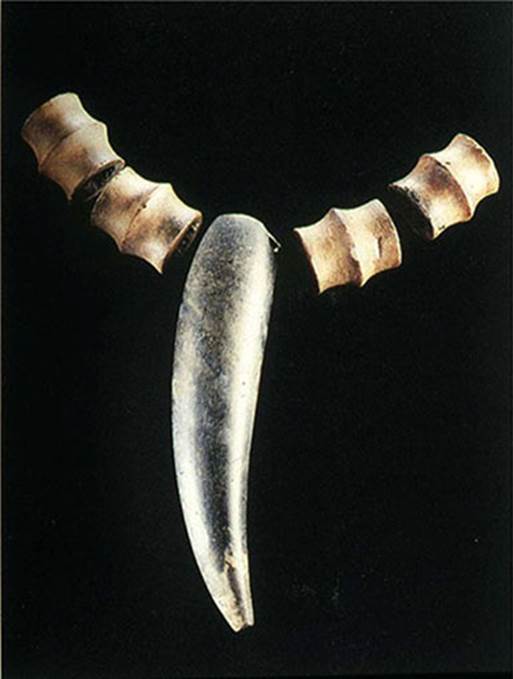
|
Reel ornaments, somewhat resembling spools, are reported from Hawaii, Tonga, Fiji, Rotuma and Atiu in the Cook Islands, but also in North America and especially in the Ohio region.
When the skull was first found by Eyles, Rangitane Elder, Manny MacDonald, said, “It’s nothing to do with us … He’s not one of us”.
This kind of freely proffered admission used to be common and prevalent amongst the learned Maori elders: Historian Edward Tregear observed:
“The Maoris used to pay great respect to the bones of their dead, yet here and there may be found among sandhills, etc., human remains uncovered by the wind, and of these no tradition remains, as there would certainly be if the relics were those of ancestors. The natives say, “These are the bones of strangers.” So also mortuary-caves are found concerning the contents of which the Maoris make the same remark, and regard them with indifference (See, The Maori Race, by Edward Tregear, pp. 562-563).
This initial exhumation, featuring a human burial with a large Moa egg ritually placed adjacent to the deceased, recurred many more times as other graves were found and exhumed.
In fact, the first of these ritual burials of a Moa hunter skull and Moa egg to be found together in situ was in the 1850s, during excavations for the foundations of Mr. George Fyffe’s Kaikoura district home. (See: Old Marlborough, by TL Buick, 1900, page 384).
It was rare to find complete or intact Moa eggs in the graves, as most had crushed under the weight of overburden soil. Some found in various locations around New Zealand were of such great age that the shell fragments quickly crumbled to powder once exposed to oxygen.
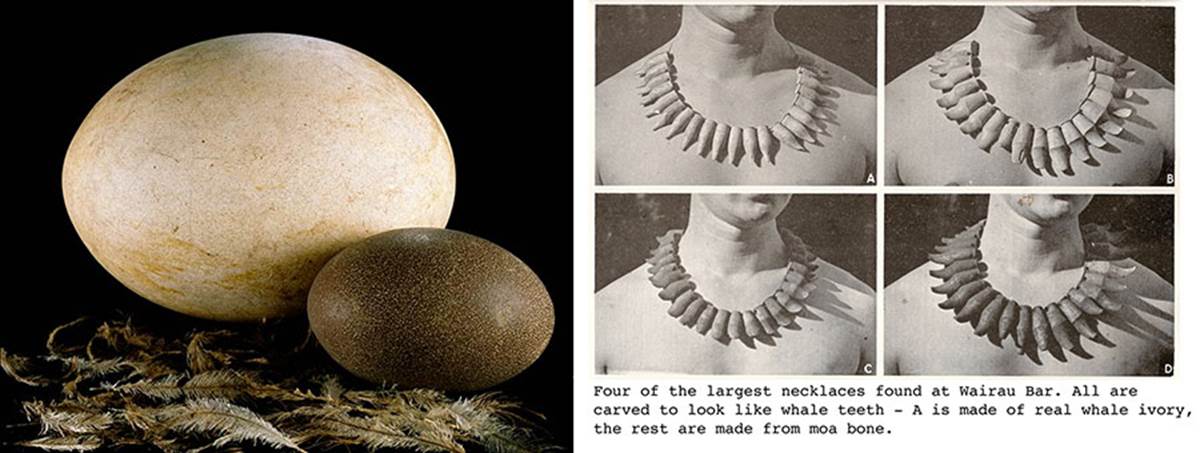
To the left is seen an ancient Moa egg dwarfing an Emu egg. To the right are seen four sets of whale-teeth necklaces, only one of which is made from real whale ivory. What cultural importance did the whale have to account for such a degree of laborious carving?
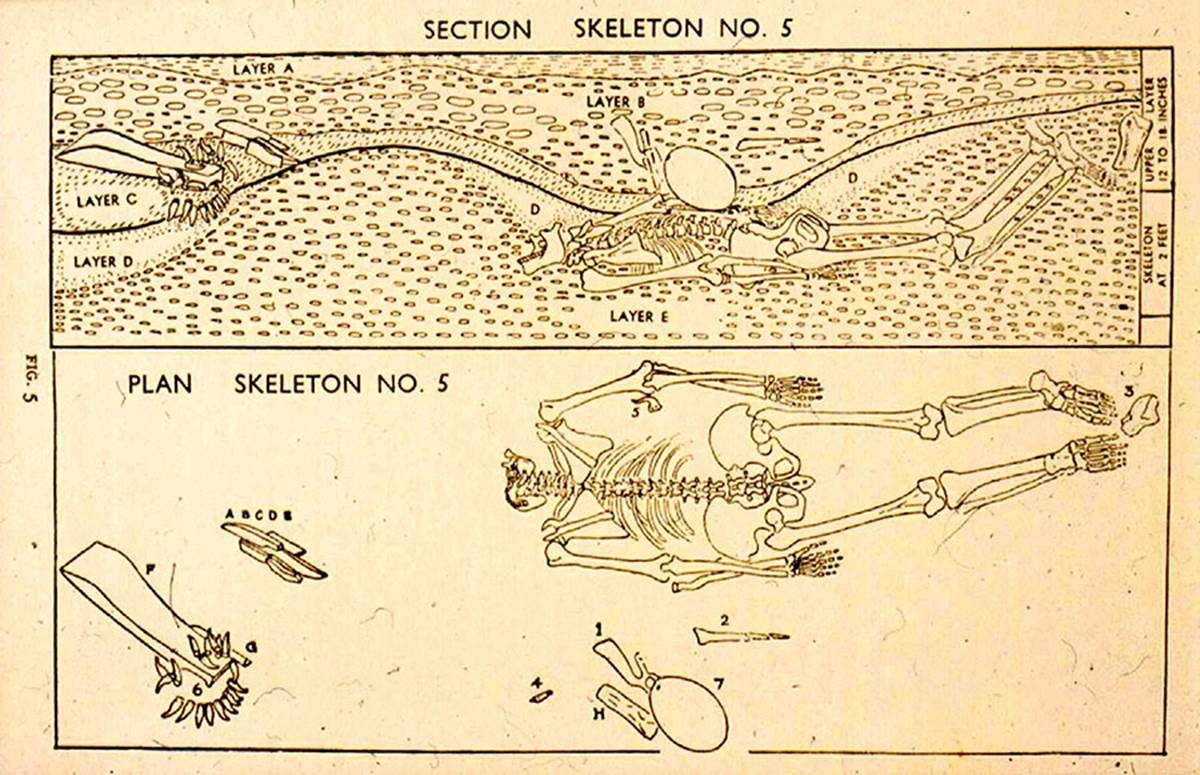
Wairau Bar skeleton 5 was missing its skull, except for the jaw – this was probably taken post-burial for some reason. A cache of 5 adzes (A-E) was nearby. Adze F is particularly unusual. It had a necklace of imitation whale teeth, made of Moa bone, wrapped around it (6). A piece of Moa leg bone was placed upright between the feet (3) as some kind of burial offering. 7 is a broken egg.
In the above archaeological drawing, the mandible (jawbone) is clearly seen to have an upwards running curve at the lower border. Photographs taken at the site also confirm the flat jaw type. This is, therefore, not a Polynesian individual, whose jawline would exhibit a continuous downwards curve on the lower border of the mandible (rocker jaw).

To the extreme left is the slightly upwards curved mandible of a European, shown adjacent to a pre-colonial Polynesian-Maori skull (centre). To the right is seen a skull photographed in situ within a very remote cave of the central North Island.
The skeleton had previously been assessed by a professional archaeologist, as the very old, “Moa-Hunter” physical type in his statement to the farmer upon whose property it was found. The jawline is the flattish, upwards curved mandible and positively not a rocker jaw. Also, the line from the chin, past the nasal cavity misses the brow by a reasonable distance, whereas the same line would touch the brow on the pre-colonial Maori skull. (See: The First New Zealanders, by Phillip Houghton, Hodder & Stoughton Ltd, Auckland, London, Sydney, 1980). It will provide all of the major physical trait differences to look for between Polynesian-Maori and European skeletons.
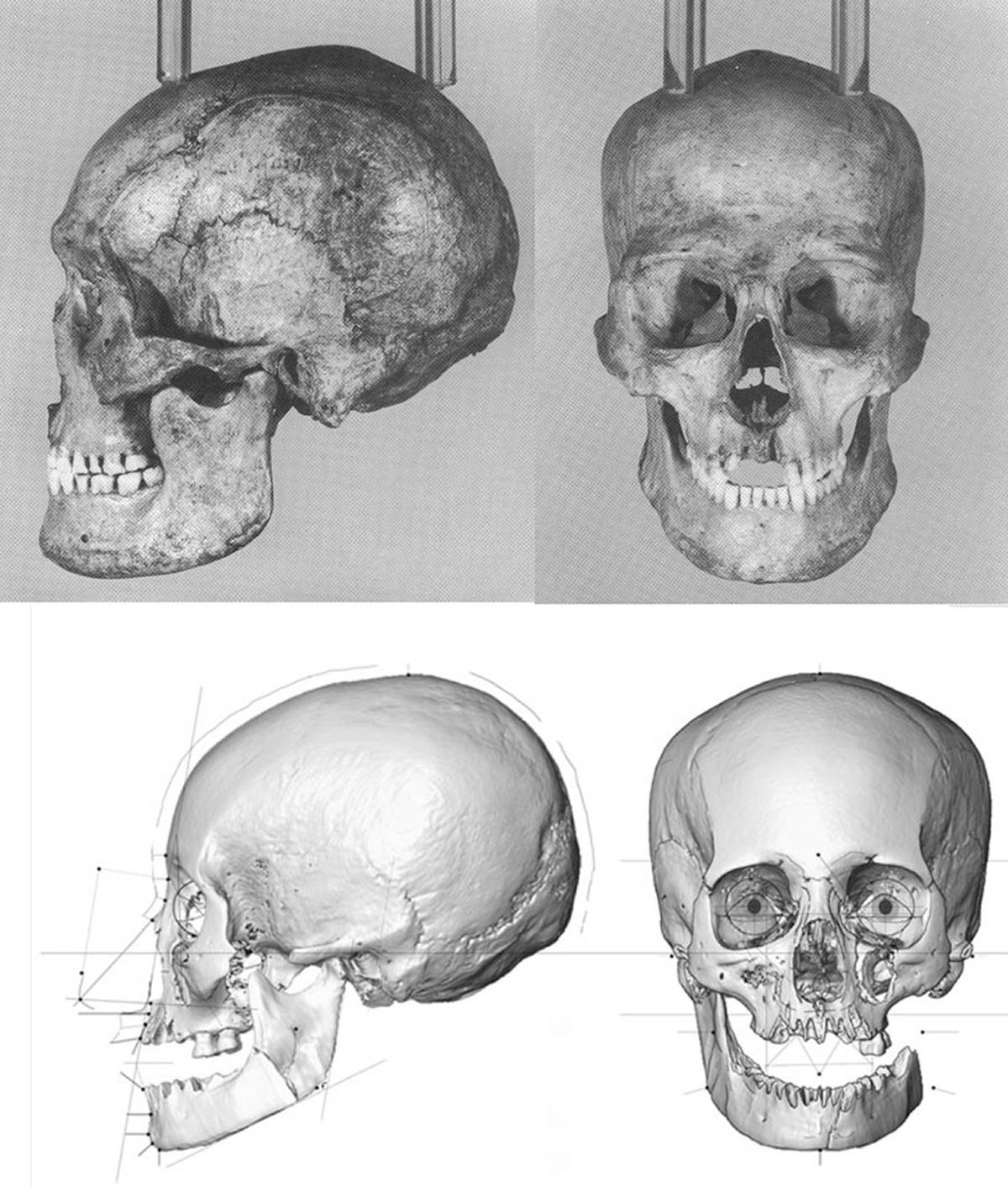
The top row shows a Polynesian-Maori male skull that displays the following typical, basic features of Polynesian physiology: In the lateral view, the vault is high, coming to a point; the lower border of the mandible (jaw) has a continuous convex curve, without an angular notch; the facial profile is vertical and straight, with the chin point well forward to form a flat face, where the line from the chin passing the nasal cavity touches the brow. Viewing the skull from above or from behind shows it to be pentagonal and quite distinctive in its general physiological features.
By comparison, the face of “Aunty” (bottom row), as well as the male skulls from Wairau Bar that were similarly analysed, do not display the high, pointed vault, nor do they show a rocker jaw. The lower border of the jaws are flat, whereas the facial profile is not. A line running from the chin, then touching the nasal cavity protrusion would miss the brow by a significant margin.
The all-too-convenient classification of Aunty as “Polynesian” or “Polynesian-Maori” seems to have been motivated by the obligatory imposition of politically-correct outcomes designed to fudge the archaeological results, unless the terms of reference as to what defines a “Polynesian” physical type are so wide-open that no craniological guidelines apply.
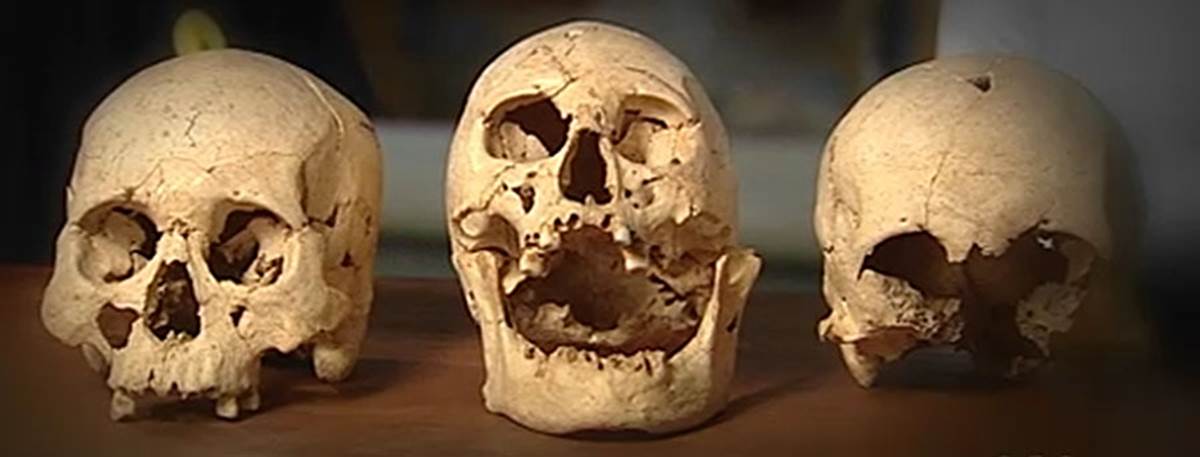
The jaw (mandible) sitting below the centre skull does not actually go with that skull, which is female. The other two skulls are male.

These are the 3 ancient Lapita skulls given facial reconstruction by Susan Hayes. The skull and jaw shapes seem to closely resemble that of “Aunty” from Wairau Bar, New Zealand. The jaw sits firmly on a flat surface, whereas the Polynesian rocker jaw would not. DNA tests showed the Lapita People to be absent of a DNA marker that 95% of Polynesians have.
Secondly, with regards to “Aunty” at Wairau Bar … as Dr Knapp and the Internet state:
Mitochondrial (mtDNA HVR1) testing will only show a 'basic maternal ancestry'. This level of analysis is nowhere near as comprehensive as Nuclear DNA genome testing. Mitochondrial DNA testing can even have results as far flung as having two siblings with no matching results, and it is well known that this test is the most simplistic and basic of the two. Items that should have been made available for a more comprehensive Nuclear DNA test have now been buried by the Rangitane iwi as of 2009, and until the final results were undertaken the tribe certainly had no moral right to do so.
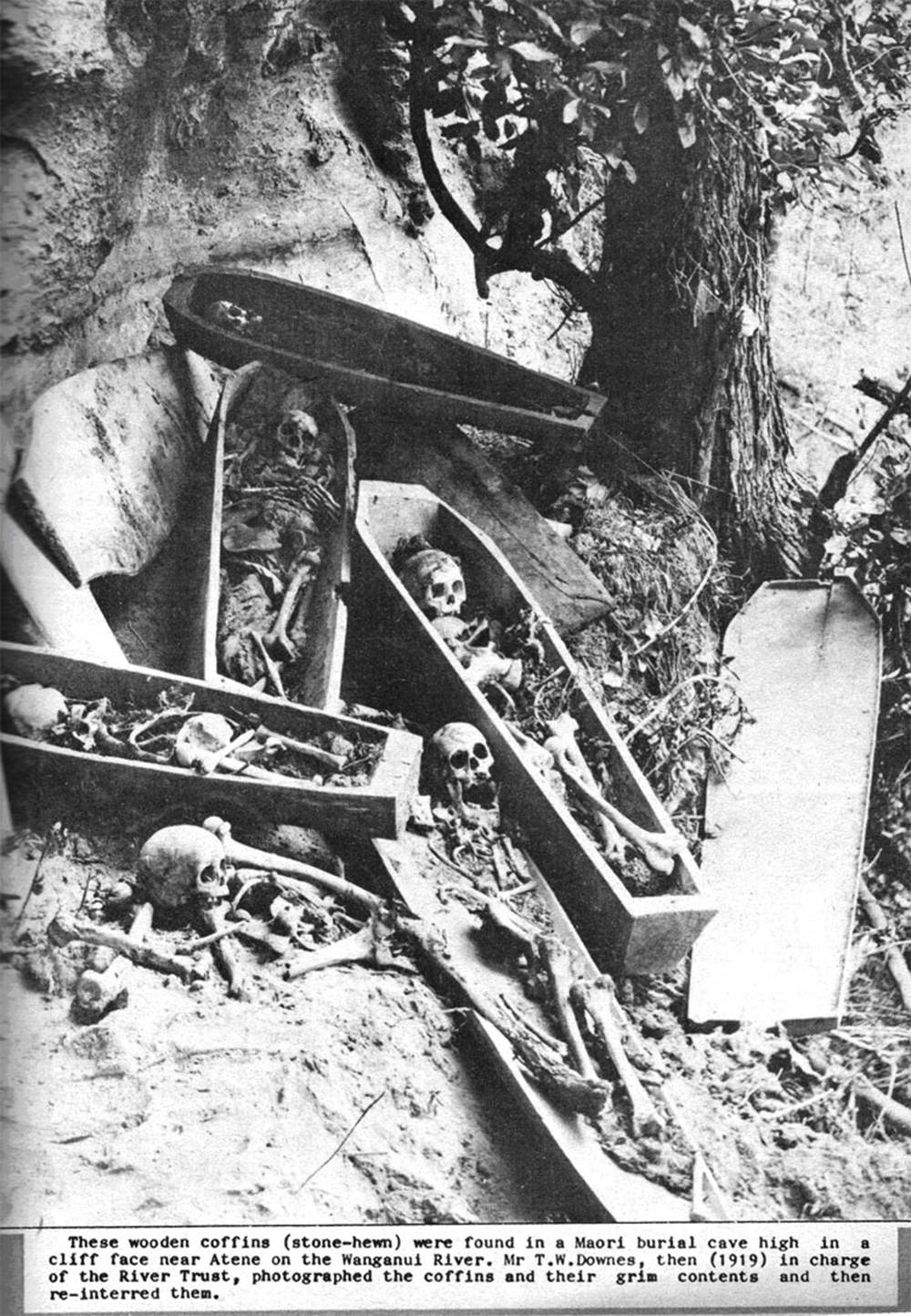
The coffins seen above were photographed in 1919 high up a cliff-face at a very remote and rugged part of New Zealand. Each coffin was hewn-out by stone tools from a single log, like a dugout canoe.
These coffins were not planked or made from sawn timbers, as one would expect colonial-European coffins to be fabricated at any point during the colonial era. The lids were also hewn from a single, thick plank, with the edge lip (used for locking the lid firmly onto the coffin box) laboriously carved by scalloping out the central region. The cultural habit of carving coffins in this manner, as single hewn pieces, is reminiscent of the mummy-boards of Egypt, which fully encased the body of the deceased. One skeleton lies on what appears to have been the base of an old canoe.
These skeletons display recognisable European physiology. They were already very old when found in isolated country, far from the consecrated ground of a churchyard. The deceased people were, undoubtedly, the white Ngati Hotu, known in local Maori and European folklore to have hidden from the cannibals for centuries in this inhospitable region. The location was less than 50-miles further into the rugged 'bad-lands’ interior from where the last of the Ngati Hotu tribe were defeated and cannibalised in the “Battle of the Five Forts” at Pukekaikiore (hill of the meal of rats).
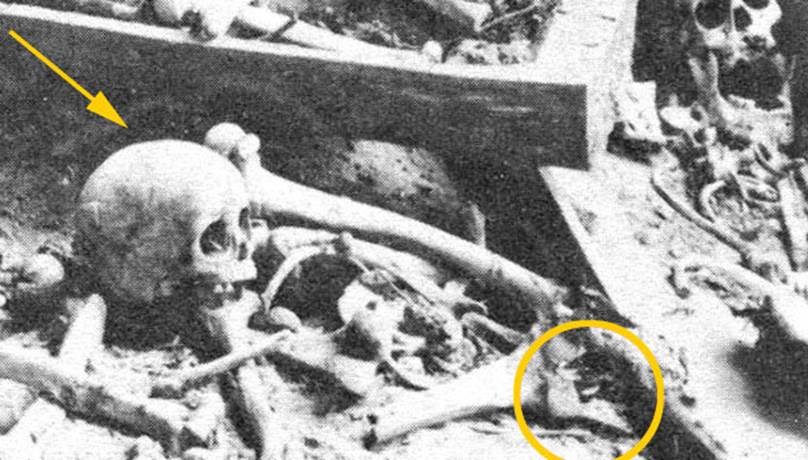
A blow-up of the picture positively shows a side view of a jaw (mandible) adjacent to the canoe base, which is not the Maori-Polynesian rocker jaw with a continuous downwards curve on the lower border. Further to that, the craniums are very round. The face line from the jaw past the nose and brow is inconsistent with the Maori flat facial profile.
Phillip Houghton, in his book, The First New Zealanders, 1980, offers comparisons between the Maori-Polynesian physiology and that of other racial groups (yellow lines & numbers added).
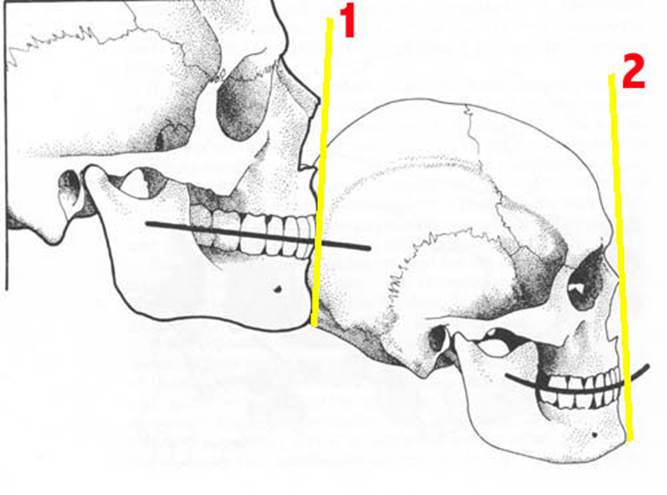
The cranial image to the left is typically European, showing the face line, straight set of the teeth and upward indented or straight-flattish mandible. The skull to the right is Polynesian Maori, which varies markedly from these features, including the very distinctive rocker jaw and general shape of the cranium. For anyone seeking a comprehensive description of skeletal differences, Houghton’s book is a valuable resource.
Houghton writes:
'When the Polynesian skull is placed beside that of a European, or any other race, differences can be seen. The Polynesian head, particularly of the male, is more angular, appearing distinctly pentagonal from above or behind, compared with the rounder contour of the European. The region of the temples is particularly flat in the Polynesian, and the bridges of bone known as the zygomatic arches stand well clear of the cranial contour, being visible from above. In the heads of most races these arches are usually concealed by the cranial contour in this view.
Viewed from the front the face appears flat-sided with the cheekbone turning back at right angles to the facial surface. Viewed from the side the face of the Polynesian appears flat, vertical in profile, and not usually with any projection of the front teeth and their supporting bone as commonly seen in Negroes, in whom also the point of the chin may be set back so that the whole of the mid-face appears to project forward. The vault of the Polynesian cranium is high. And from the side view is seen what is probably the most distinctive Polynesian feature of all, the shape of the mandible. The lower border of this bone shows a continuous and marked convex curve from front to back. This means that when the isolated bone is placed on a flat surface it makes contact at only two points, and therefore rocks when disturbed. This has given rise to the term familiar to Oceanic anthropologists as describing the Polynesian mandible - the rocker jaw.' (See The First New Zealanders, pp. 41-44, with illustrations).
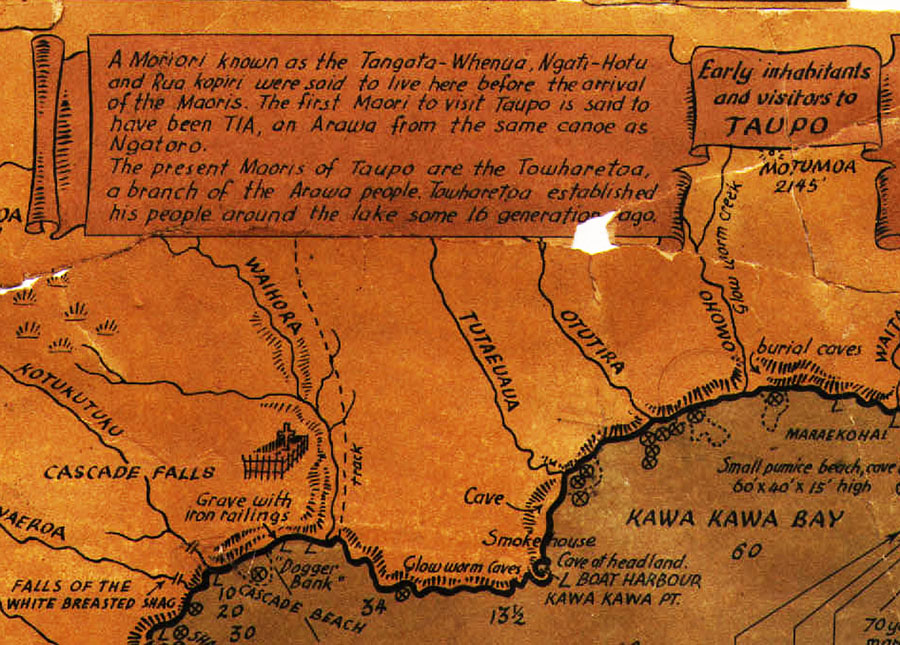
A 1920s tourist map of Lake Taupo provides snippets of, what these days would be, censored history that goes unmentioned in the cultural-Marxist versions taught in our schools. It makes mentioned of the once well-known fact that there was a long-established civilisation living in New Zealand before Maori arrived from Polynesia-Melanesia in about 1250 AD - 1300 AD. The original inhabitants of the Taupo region were called, by Maori, Ngati-Hotu.
Here are a few sample descriptions of what the pre-Maori people looked like, as recounted by the learned Maori elders of seemingly every iwi throughout New Zealand:
‘Generally speaking, Ngati Hotu were of medium height and of light colouring. In the majority of cases they had reddish hair. They were referred to as urukehu. It is said that during the early stages of their occupation of Taupo they did not practice tattooing as later generations did, and were spoken of as te whanau a rangi [the children of heaven] because of their fair skin.
There were two distinct types. One had a kiri wherowhero or reddish skin, a round face, small eyes and thick protruding eyebrows. The other was fair-skinned, much smaller in stature, with larger and very handsome features. The latter were the true urukehu and te whanau a rangi. In some cases not only did they have reddish hair, but also light coloured eyes.’
(See Tuwharetoa, chapter 7, page 115, by Rev. John Grace).
Fairly close by at Lake Rotorua the original inhabitants there were described in similar terms:
An old Maori elder said the following to historian James Cowan about the former, vanquished Ngati-Hotu of Mt. Ngongotaha in Rotorua district:
‘The complexion of most of them was kiri puwhero and their hair had the reddish or golden tinge we call uru-kehu. Some had black eyes, some blue like Europeans. Some of their women were very beautiful, very fair of complexion, with shining fair hair…'
Here’s an account of their final demise:
The battle of the five forts
‘Ngāti Hotu were found living around the shores of lakes Taupo and Rotoaira by the Ngāti Tūwharetoa iwi (tribe) in perhaps the 15th century. Ngāti Tūwharetoa were then resident at Kawerau and associated with Te Arawa iwi which today occupies the area from the Bay of Plenty coastline to the Lake Taupo district.
Ngāti Hotu suffered a major defeat at the battle of Pukekaikiore ('hill of the meal of rats')* to the southwest of Lake Taupo where Ngāti Tūwharetoa devastated them, causing the few survivors to flee.
Apparently some of the survivors settled around the village of Kakahi ('freshwater mussels') which lies 30 kilometres west of Lake Taupo. They were discovered there by a party of Whanganui Māori journeying up the river of the same name who soon called up reinforcements to attack the settlement.
The Ngāti Hotu set up a ring of five forts around Kakahi which the Whanganui Māori attacked and took one by one until finally the last two, Otutaarua and Arikipakewa, fell. The final, brutal episode of the battle was played out on the flats between Kakahi and the Whanganui river when the now, effectively victorious Whanganui Māori hung the legs of fallen Ngāti Hotu warriors from poles mounted in the forks of trees - a gesture at which their remaining enemies broke and fled off into the depths of the King Country to vanish from history.
The battle is estimated to have occurred circa 1450 and its story has since been handed down through 15 generations to the Whanganui kaumatua Takiwa Tauarua, who related it to prominent New Zealand artist Peter Mc Intyre in the 1960s.’
*Footnote: The “hill of the meal of rats” refers to the fact that the defeated Ngati Hotu were cannibalised. Also, it was common for the pre-Maori people to live in underground dwellings and these can still be found in their thousands around the Rotorua lakes, Taupo and at many defensive enclosures like Koru PA, etc. I’ve been told that Maori used to say or complain that the pre-Maori people, “ tunnelled like rats”, hence, the term, Pukekaikiore.
See: McIntyre, Peter (1972). Kakahi, New Zealand. Reed, ISBN978-0589007423
Similar descriptions as to the physical appearance of the original New Zealanders are found in the oral-traditions of Maori tribes across the length and breadth of New Zealand, but in this new age of grand enlightenment, for racial sensitivity reasons, these most ancient, long-term inhabitants are not allowed to be remembered!
The more general umbrella terms for these people were Patu-paiarehe and Turehu, although Maori tribes had many other regional names for the original inhabitants hiding out in the high country after being forced to abandon their former lands of possession to Maori conquerors.
The following quotes, in part, Hone Mohi Tawhai, son of the Hokianga-based tohunga chief, Mohi Tawhai:
‘Well instructed men among the descendants of the Matahourua migration say that when their ancestors arrived in Hokianga they found a people known as "Turehu." Here again we meet with a similar idea to that prevailing among the Aotea people.
The Turehu were said to be "He iwi wairua" (a ghostly people). But side by side with this statement we have an admission. When a child was born [among the northern people] with reddish hair and a fair skin, it was commonly exclaimed "Ae he Turehu" (yes, this child is a Turehu).
The late Hone Mohi Tawhai, who had been carefully instructed by his father, Mohi Tawhai, a renowned priest and warrior of Hokianga, said on one occasion to the writer ;
"What do you think will be the destiny of the Maori people?" We replied: "They will be ultimately absorbed in the European people." The reply came: "I think you are right. When the ancestors of the Maori people came to this land they found a people called "Turehu" and they fought with them and-intermarried with them, and they were lost in our race. The Europeans have fought with the Maori people and inter-married with them, and we shall be lost in your race."
Under other circumstances Tawhai would probably have spoken of the "Turehu" as a ghostly people and charmed his hearers with many fairy tales of this marvellous people, who formerly lived in the mountains, and time and again came down in the gloaming and spirited away children of the Maori people who resembled their own race’.
https://paperspast.natlib.govt.nz/newspapers/HNS19151119.2.3
UNDERGROUND HOUSES

Inside a souterrain dwelling at Lake Okataina, Rotorua district.
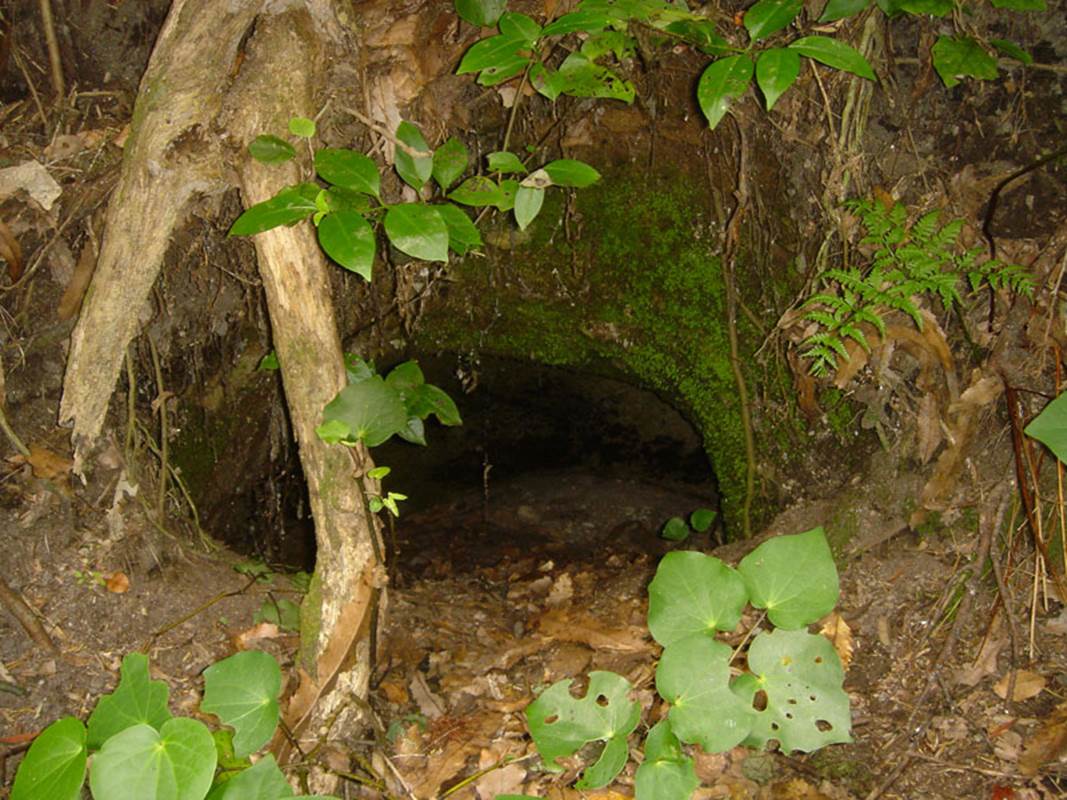
These are around the Rotorua lakes and elsewhere in their thousands, but many of the as-yet detectable entrances are now half-full of detritus due to centuries of neglect and abandonment.
They were the underground domiciles of the Ngati Hotu fairy folk, subsisting around the lakes of the inhospitable Central Volcanic Plateau after being vanquished from their coastal settlements at Hawkes Bay. The incoming Arawa and Tuwharetoa invaders finally ousted them from this district as well, forcing survivors to flee into the yet more rugged and inhospitable hinterlands above the Whanganui River.
Continue













